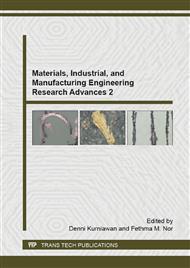[1]
Wei Zhou, Tian Shen, and Naing Naing Aung, Effect of Heat Treatment on Corrosion Behaviour of Magnesium Alloy Az91d in Simulated Body Fluid, Corrosion Science, 52 (2010), 1035-41.
DOI: 10.1016/j.corsci.2009.11.030
Google Scholar
[2]
Y. W. Song, D. Y. Shan, and E. H. Han, Electrodeposition of Hydroxyapatite Coating on Az91d Magnesium Alloy for Biomaterial Application, Materials Letters, 62 (2008), 3276-79.
DOI: 10.1016/j.matlet.2008.02.048
Google Scholar
[3]
Hazibullah Waizy, Jan-Marten Seitz, Janin Reifenrath, Andreas Weizbauer, Friedrich-Wilhelm Bach, Andrea Meyer-Lindenberg, Berend Denkena, and Henning Windhagen, Biodegradable Magnesium Implants for Orthopedic Applications, Journal of Materials Science, 48 (2013).
DOI: 10.1007/s10853-012-6572-2
Google Scholar
[4]
J. Nagels, M. Stokdijk, and P. M. Rozing, Stress Shielding and Bone Resorption in Shoulder Arthroplasty, J Shoulder Elbow Surg, 12 (2003), 35-9.
DOI: 10.1067/mse.2003.22
Google Scholar
[5]
H. K. Uhthoff, and M. Finnegan, The Effects of Metal Plates on Post-Traumatic Remodelling and Bone Mass, J Bone Joint Surg Br, 65 (1983), 66-71.
DOI: 10.1302/0301-620x.65b1.6822605
Google Scholar
[6]
Mark P. Staiger, Alexis M. Pietak, Jerawala Huadmai, and George Dias, Magnesium and Its Alloys as Orthopedic Biomaterials: A Review, Biomaterials, 27 (2006), 1728-34.
DOI: 10.1016/j.biomaterials.2005.10.003
Google Scholar
[7]
P. K. Sullivan, J. F. Smith, and A. A. Rozzelle, Cranio-Orbital Reconstruction: Safety and Image Quality of Metallic Implants on Ct and Mri Scanning, Plast Reconstr Surg, 94 (1994), 589-96.
DOI: 10.1097/00006534-199410000-00004
Google Scholar
[8]
Y. Xin, T. Hu, and P. K. Chu, In Vitro Studies of Biomedical Magnesium Alloys in a Simulated Physiological Environment: A Review, Acta Biomaterialia, 7 (2011), 1452-59.
DOI: 10.1016/j.actbio.2010.12.004
Google Scholar
[9]
Frank Witte, Norbert Hort, Carla Vogt, Smadar Cohen, Karl Ulrich Kainer, Regine Willumeit, and Frank Feyerabend, Degradable Biomaterials Based on Magnesium Corrosion, Current Opinion in Solid State and Materials Science, 12 (2008), 63-72.
DOI: 10.1016/j.cossms.2009.04.001
Google Scholar
[10]
K. J. Burg, S. Porter, and J. F. Kellam, Biomaterial Developments for Bone Tissue Engineering, Biomaterials, 21 (2000), 2347-59.
DOI: 10.1016/s0142-9612(00)00102-2
Google Scholar
[11]
P. S. Nicholson, P. Sarkar, and X. Haung, Electrophoretic Deposition and Its Use to Synthesize Zro2/Al2o3 Micro-Laminate Ceramic/Ceramic Composites, Journal of Materials Science, 28 (1993), 6274-78.
DOI: 10.1007/bf01352183
Google Scholar
[12]
M. Wei, A. J. Ruys, B. K. Milthorpe, and C. C. Sorrell, Solution Ripening of Hydroxyapatite Nanoparticles: Effects on Electrophoretic Deposition, J Biomed Mater Res, 45 (1999), 11-9.
DOI: 10.1002/(sici)1097-4636(199904)45:1<11::aid-jbm2>3.0.co;2-7
Google Scholar
[13]
M. Wei, A. J. Ruys, B. K. Milthorpe, C. C. Sorrell, and J. H. Evans, Electrophoretic Deposition of Hydroxyapatite Coatings on Metal Substrates: A Nanoparticulate Dual-Coating Approach, Journal of Sol-Gel Science and Technology, 21 (2001), 39-48.
DOI: 10.1023/a:1011201414651
Google Scholar
[14]
Byung-Dong Hahn, Dong-Soo Park, Jong-Jin Choi, Jungho Ryu, Woon-Ha Yoon, Joon-Hwan Choi, Hyoun-Ee Kim, and Seong-Gon Kim, Aerosol Deposition of Hydroxyapatite–Chitosan Composite Coatings on Biodegradable Magnesium Alloy, Surface and Coatings Technology, 205 (2011).
DOI: 10.1016/j.surfcoat.2010.11.029
Google Scholar


